As has happened many times before, this Wood Journey began with no idea of the journey's destination. I've learned to just go with it, pretty sure I'll find out why later. InTHIS case it became a ZenThing.
My tree trimmer friend, Joe Ross, has given me some interesting pieces of trees over the years. Last year (2011) he brought me six big, thick, very dry, slabs of old growth Coastal Redwood root burl slabs. That root burl wood was shared with 52 turners in 22 states, a couple of turners in New Zealand (Terry Scott and Dick Vietch), and became the Pay It Forward Project. Participants agreed to make some kind of contribution to an organization in their area that helps people in need.
Last summer (2012), Joe told me about some large interesting chunks of redwood that had been dumped in a ravine up in the Santa Cruz mountains probably 10 or more years ago. The Loma Prieta Fire burned through the area where this wood was found - about four years ago, and this wood was already dry when it was charred. Given its thickness, drying enough to char this way would take probably 8 or 10 years.
This is what Joe brought me.
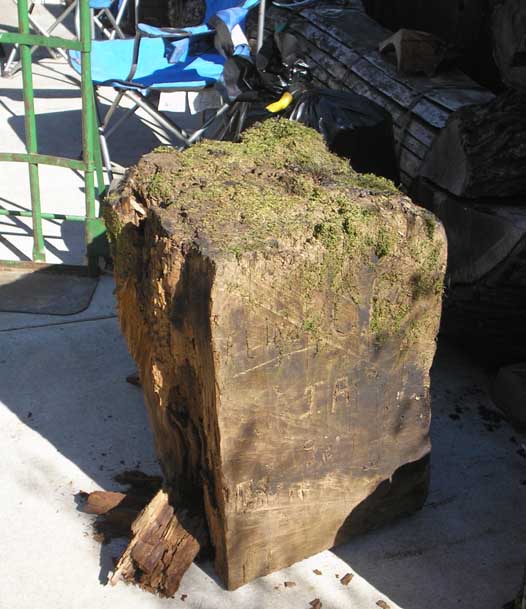
The charred and weathered surfaces, the letters carved in one side and the moss growing on it intrigued me.

This lower side apparently sat in water part of the year and dried out part of the year. Repeated wet / dry cycles caused, as you can see in the photo below. dry rot. (that dry rot would come in very handy later on) Somewhere along the line a fire swept through the gully where this wood was found, charring the top and what had been the outside of the tree. The charred surfaces provided an environment for moss to grow. The tops of the Santa Cruz mountains are often shrouded in clouds, further enhancing the opportunity for moss to grow.

It was the unusual live moss that provided the direction for this journey.
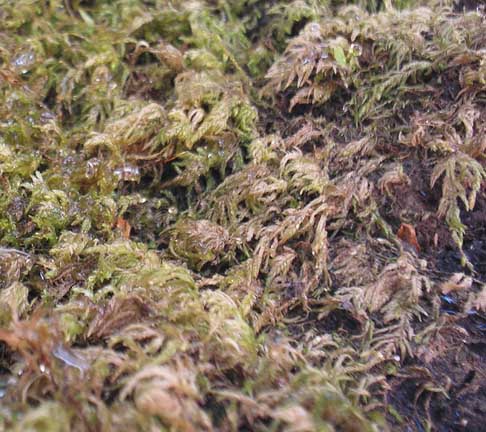
Moss needs water and the charred and mossy top of the piece begged for a place to hold water for the moss. AH! - a VERYdifferent take on the usual Natural Edge Bowl idea.
Having only a JET VS Mini lathe, turning this 29" tall, 20" x 20", hundred plus pound chunk of wood was out of the question. BUT - I have a chainsaw, actually two chainsaws - one electric, one gas powered . . . and it didn't take long tocarve out this bowl shaped depression.
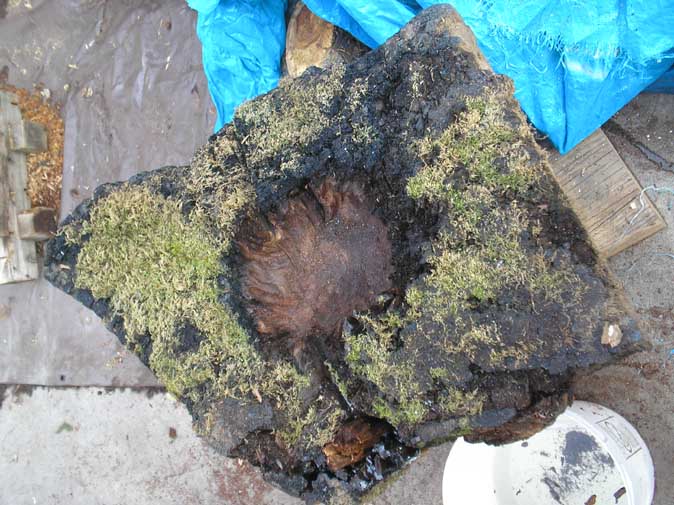
This is the charred outside face of the tree.
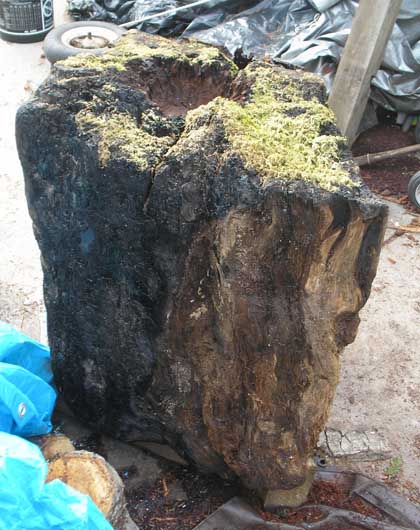
Photos don't convey a sense of scale very well. Here's this chunk of redwood in a context that may do a better job of conveying the size of the tree it came from. It wasn't a GIANT redwood, more like the average size redwood found now in the Santa Cruz mountains. Some measurements of the curvature of what was the outside of the tree, a little geometry and some calculations put the diameter of the original tree trunk at 7 1/2 feet - and that's not at its base but a ways up the tree , My guess is that the tree was well over 100 feet tall. Standing at the base of it, a human would seem rather small. That's the thing about large trees - they humble you. Even a chunk of such a thing changes your perspective of it - and maybe other things as well. The Zen Thing about this piece started coming into focus,

Now about that dry rot . . .
Water in the bowl in the top could hold water, and water might keep the moss growing on the top of the piece alive. But unless I replenished the water in the bowl, it would evaporate - and the moss would die.
BUT - if I could put a resevoir of water inside thischunk of wood - vinyl tubes from the water resevoir to and from the bowl - and added a small recirculating pump . . . I'd only have to replenish the resevoir every week or two.
Hmmmmmm . . .
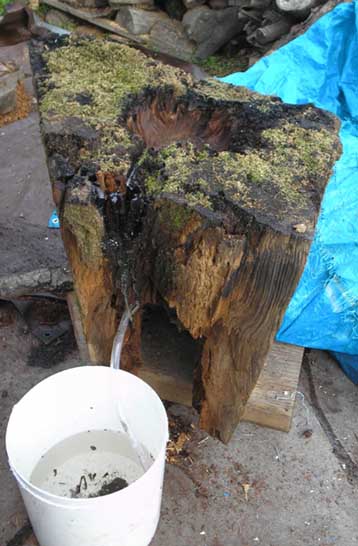 r
r
"All I needed to do" was make space inside the piece for a 5 gallon bucket. I've got two chainsaws and both have 16" bars on them. Part of the underside of the piece was dry rotted, so that would be easy to get rid of. How hard could it be to chainsaw out a hole 13" deep and 13" in diameter?
WELL -it ain't all that easy - or at least it wasn't for me.
Here's the problem. Look at the red arrows in the following illustrations. The red arrows point in the direction the teeth of the chainsaw chain are traveling. Note that the teeth moving AWAY FROM the tip of the chainsaw bar, on the bottom half of the bar - will pull the saw INTO the wood as they cut - pulling the saw AWAY FROM YOU. That's the way chainsaws are designed to CUT.
Now note the direction of the chainsaw's teeth on the top of the bar. They're moving TOWARDS the wood. They want to push - or KICK - the chainsaw bar - AWAY FROM the wood - and BACK AT YOU - VERY QUICKLY! You DO NOT want a running chainsaw coming back AT YOU - much faster than your reflexes can protect you .
CHAINSAW RULE #5
NEVER HAVE THE TEETH ON THE UPPER HALF OF THE CHAINSAW BAR CONTACT WOOD.

Two or three hours of lip biting chainsawing produced this.
Oh - and drilling two holes 20" long could've been a problem. But I've found with projects like this, that when "challenges" come up, a solution will arrive just in time. Joe, the guy who gave me this piece of wood, also just happened to have a boring bit that was a bit over 20" long. Coincidence? This is the type of thing that tells me the process I'm being a part of is supposed to be happening. Again, it's a Zen Thing.

Space for a bucket, holes for a water inlet and outlet tube, vinyl tubing to connect to a littlepump - things were coming together.
While at a Home Depot, out in the garden area, looking for some plants for the house, I came acrossed some small circulating pumps - ON SALE. One was perfect for this project - and with adjustable flow volume. A Zen Thing - everything coming together "just so". If you're an "A-Team" fan it's more like - Don't you love it when a plan comes together! (even if there really wasn't any plan to begin with?)
Here are some shots of the finished piece that give you an idea of this piece.
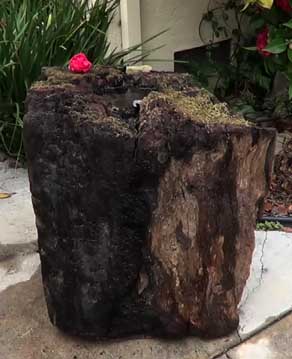
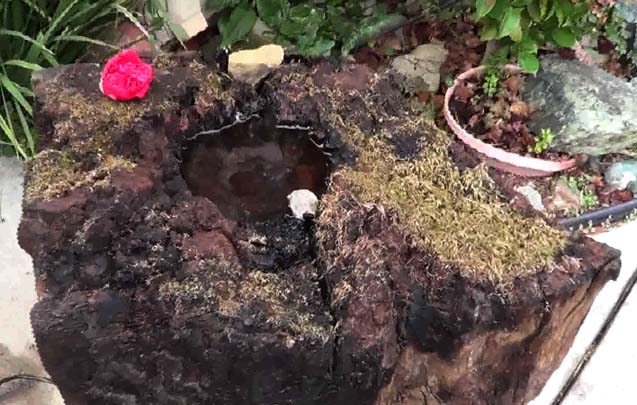
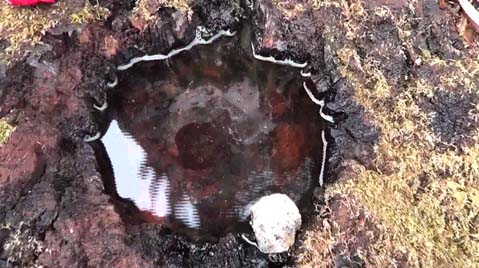

The size of the piece get's your attention and the moss draws you in. As you get closer the slightly rippling surface of the water pulls you closer and as you get closer the sound of tinkling, splashing water begins to be audible. By the time you get up in front of the piece, you've begun to leave the Day To Day Normal World behind, and begin transitioning into a quieter, calmer, more contemplative place. As you really start to look at this piece of charred, weathered, moss covered wood and the little pool or rippling water, the sound of the water becomes mesmerizing, drawing you farther and farther from the Day To Day - and towards a different. more introspective.thoughtful place.. Itcan become a Zen Thing.
Still photos can't show movement and can't let you hear the sounds of this piece. To see the subtle movement and hear the subtle sounds CLICK HERE to see a YouTube video of this piece.